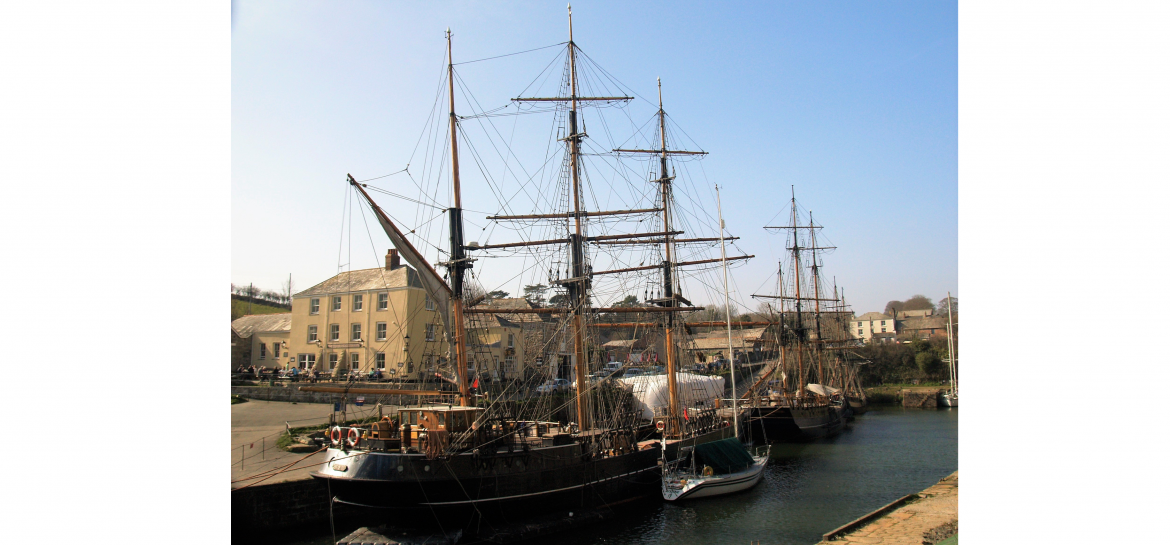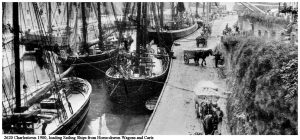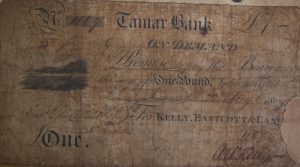Banking in Cornwall – Part 1: Eighteenth-century beginnings
Categories Articles, Commerce & Industry4 Comments
Charlestown Harbour, shown here as it appears nowadays in a photo by Terry Knight, was begun in an age which also responded to the need for effective finance of the developing trade and industry of Cornwall. John Dirring begins to tell the story of banking in Cornwall with a consideration of its origins in the late eighteenth century.
The story of Cornish banking is a long and rich heritage, intertwined with many other aspects of Cornish life and enterprise. This is the first part of an intended series relating the history of the banks themselves – and more especially that of the bankers, men and women, who made (and lost) their fortunes in them. Here the early players in the financial game in Cornwall are introduced, with the issues they faced and the social and financial landscape in which they moved.
The first banks established as such in Cornwall were the Miners’ Bank and the Cornish Bank, both started in Truro in 1771; although some banking services had been available long before this, formally and informally, from various providers. The last independent Cornish bank was Dingley’s of Launceston, absorbed by the National Provincial in 1922 – which became part of the familiar NatWest in 1968, a corporate banking giant remote from the early days of small beginnings.
Banking began in Cornwall on a small and localized scale, as did all the banks that were appearing in ever-greater numbers over in England and Wales. Financial services of various kinds had already been offered for over a century in London. The Bank of England, legislated into existence in 1694 to help meet the financial exigencies of the government of the day, was a joint-stock bank with a large capital contributed by many shareholders. It had been given a monopoly of this form of organization in banking in 1708. All other banks in England and Wales, and in Cornwall, were restricted to no more than six partners – a situation which continued until 1826. The structure of banking developed differently in Scotland; where the Bank of Scotland, chartered in Edinburgh in 1695, had no joint-stock monopoly. There were no limits to the sizes of the copartneries which formed the first Scottish provincial banks, some of which had large numbers of partners.
With their capital thereby limited to the personal wealth of the partners themselves, the `country’ banks outside London (as they were known) tended to remain small within their own communities, with each town and commercial centre having its own independent banks. The business of banking became a matter of personalities and individual dealings, rather than formal institutions. Bankers, with unlimited liability for their debts and obligations, traded on their reputations; operating in a business environment in which credit was socially-determined.
Information on banking in Cornwall was first gathered together by George Clement Boase in his Collectanea Corbiensia. Published in Truro in 1890, it has a section listing the banks in Cornwall town by town; with dates, branch locations, names of partners, managers and agents and other details. This work is comprehensive and authoritative, though sometimes in need of qualification. Boase himself (1829-1897) had been involved in banking in his younger days, in both Penzance and London. It was a timely record when it appeared, as many of the once-familiar names in Cornish banking were about to disappear in impending amalgamations.
Throughout Britain, it was natural for traders of all kinds, who offered customary and expected credit to their customers for goods supplied and services rendered, to start taking deposits and lending them money; and for attorneys, used to handling financial transactions and conveyancing for their clients, to seek borrowers for surplus funds and lenders to finance mortgages. In Bodmin, George Browne had been practising law since 1744; and along the way had been offering services of this kind more generally, sometimes in partnership with John Bennett and John Wallis. After Browne’s death in 1790 Wallis (1759-1842), who was a prominent citizen of Bodmin, continued the business until 1827, latterly also operating in Bude.

This was a natural role for such figures to fill; they were known and trusted in the community and had visible wealth. Depositors needed a tangible assurance that the funds they entrusted to those setting themselves up as bankers would be repaid on demand or at short notice. As Susan Gay relates in Old Falmouth (1903), Richard Pidgley (1740-1802), sometime Recorder of the town, was also an early occasional provider of banking facilities, on a similar basis of public trust.
Falmouth, as a major trading port, was naturally full of business transactions and consequent financial needs; and became one of the first places in Cornwall where banking developed. Another prominent citizen of the town was Joseph Banfield (1737-1823), a shipping agent and broker active in a business where risks were great but finely calculated and balanced; he also handled its financial aspects. There was every confidence in Banfield’s ability to shoulder such responsibilities and others besides; and he served as Mayor in 1788. At times, he also looked inland, joining in the leasing of mining setts; it was an age in which those of an entrepreneurial bent were willing to try anything that might turn out to be profitable. A hard act to follow, his business had no direct successors; and on his death in 1823, the title and goodwill of his `Falmouth Bank’ passed to the Carne family of Killigrew Street in Falmouth, wine merchants and importers who had themselves been involved in banking since 1781 as an adjunct to their trade.
In another coastal location, Hugh Edwards also began offering banking services in St Ives in 1782; while two years later Christopher Wallis, a Helston attorney, found banking to be a natural extension of his involvements in mining. So did the Grylls family, also practising law in Helston and entering banking from 1788; and the Gundrys of Goldsithney, issuing notes in payment of wages in 1790. All these personalities were prominent in the financing and management of Wheal Vor, the great mining venture on which the fortunes of the town became greatly dependent. Tony Bennett has recently untangled their animosities in his history of the mine (2015). The story of banking in Helston is a long tale of slow decline, culminating in the persistence of Cordelia Vivian and Edward Kendall in maintaining the Grylls’ Helston Union Bank over many years until its demise in 1879.
In the fishing community of Polperro, Zephaniah Job had begun a career as schoolmaster; but his accounting and management skills were soon in demand, to assist the clandestine `free trading’ networks which permeated the Cornish coast (and all around Britain) at this time, to the point where he had become the `Smugglers’ Banker’ by 1789. Jeremy Rowett Johns has researched his surviving papers in the Courtney Library in Truro; on Job’s death in 1822, his former clients had made a bonfire of the more incriminating records.
In Penzance, the first bankers were Scobell, Blewitt & Co in 1792; but only until 1795. In that year, John Batten, Richard Oxnam and William Carne came together in a banking partnership which joined their other activities in ship owning, merchanting and tin smelting. The Oxnam family were used to taking risks; in the American War of Independence, they had turned their ships to privateering – in this age of almost endemic naval warfare, private enterprise on all sides of a conflict could join in for profit, with recognized `letters of marque’ from their governments; legitimising what was effectively a licensed form of piracy against enemy shipping.
In mid-Cornwall, Charles Rashleigh and Edward Coode were dominant personalities in St Austell. Rashleigh was the founder of Charlestown, creating a safe harbour on an otherwise exposed coast; and as Rashleigh, Coode & Kempthorne they were long time legal practitioners, entering banking by 1793. They were not generally known as bankers, however, until the 1820s; and their St Austell Bank was kept strictly separate from the law practice. They were very cautious in their financial dealings, eventually occupying a niche in the market alongside the much larger East Cornwall Bank, in which Edward Coode was also involved alongside the Bolithos from its inception in 1807. The St Austell Bank continued until 1920, when it was taken over by the National Provincial; but the law firm continued in practice. Charlestown in 1900 was a china clay port (China Clay History Society)

Different from all these were the Miners’ Bank and Cornish Bank in Truro; for in 1771 they had been established as banks from the outset, not developed from existing businesses or law practices. Members of the landed gentry, with large estate and property interests in Cornwall and political involvements in London as Members of Parliament, took a main part; alongside wealthy merchants with large commitments as mining adventurers. Both banks were set up to provide financial support and opportunities for their partners, and to facilitate their transactions in Cornwall and London. Both partnerships were effective coalitions of business and political interests, although in time they became purely financial institutions serving the local business community around Truro. The Cornish Bank, though professionally managed by the Tweedy family after 1800, failed in the bleak financial conditions of January 1879. This failure revealed the extent to which local businesses and public institutions of all kinds had come to rely on the bank.
These then were the banks and bankers operating in Cornwall by 1800. Their backgrounds and motives were diverse and colourful, and have only been hinted at in this brief summary. Much more of their stories will be told in greater detail in later instalments of this narrative. As in England and Wales, they were to be joined by many more practitioners in the ensuing decade, as the opportunities and demands of the Napoleonic War called forth a great extension of banking facilities. But for now, this introduction will be concluded with a look at how they operated and under what conditions, to give an idea of what it was like to be a banker in Cornwall in these pioneering times.
The greatest issue affecting everyday transactions in eighteenth-century Cornwall, as in the rest of Britain, was an endemic currency shortage. This had begun in the seventeenth century, and was to continue until it was finally overcome in the 1820s. Essentially, for a number of reasons, not enough coin was minted; and what was in circulation was often worn out, debased, or counterfeit. People would hang on to scarce money as long as they could, saving it for imperative needs like tax payments. They would trust their neighbours to pay what they owed when they were able, just as they hoped others would likewise favour them. Reciprocal dealings could often be offset. This informal socially based credit worked well in close-knit communities, where everyone knew everyone else and who could be trusted.
There were various improvisations to fill the need for ready money. Locally, traders needing small change for their business (chiefly public houses and some retail shops) began issuing their own tokens of small denomination – usually pennies or halfpennies. As these could be collected and exchanged in bulk at any time with the trader, they were used as money in the local economy, acceptable in the immediate area where the trader was known and trusted. Large employers also issued them for the payment of wages. The famous example in Cornwall was the `Cornish Penny’, distributed by the Williams family and redeemable in £1 lots at Scorrier House. Local traders over a wide area could therefore accept them with confidence.
For larger amounts, `promissory notes’ could be issued by those with the wealth to honour them and the reputation to make them acceptable. Circulating locally in the same way as tokens, they were adopted by the early banks as the first bank notes; it was mainly through their note issues that they became known and trusted in their communities. Few people outside trade had need of bank accounts in these times; but nearly everyone might be handling bank notes in their everyday transactions, or even keeping some as savings. Depositors might pay gold guineas into their accounts; but the bankers would prefer to issue withdrawals in notes promising to `pay the bearer on demand’; and their clients would appreciate the convenience if these promises by the banker to pay were widely accepted instead of the cash they represented. Many local notes (which were not, and never became, legal tender) were preferred even above those of the Bank of England – which were less familiar and easily counterfeited.
 £1 note of the Tamar Bank, Launceston, 1807 (Lawrence House Museum)
£1 note of the Tamar Bank, Launceston, 1807 (Lawrence House Museum)
Bankers soon realized that most of their notes in circulation around their communities would not be quickly returned for conversion into hard currency; and they could afford to issue more notes than could be immediately covered with their available funds. However, it was a matter of judgment to know when to stop, especially in boom times; the notes in circulation would inevitably come flooding back for payment in the next financial crisis.
Apart from the informal, everyday sort of credit between ordinary individuals, merchants like the Carnes in Falmouth, importing wine say from Portugal (or goods generally from anywhere), would need to pay for the cargo before it was shipped; but might not have the funds to do so until it was received, unloaded and sold, maybe several weeks later. So, using a customary method that had been in use around the world since medieval times, a bill of exchange was drawn up for the amount owing and sent to the seller, specifying the amount to be paid on a set date after the goods had arrived. The Carnes’ customers would likewise be offering bills of exchange in payment for goods supplied to them. With many other interrelated transactions going on, webs of credit would be built up – inland and around the coasts of Britain as well as overseas. These bills were transferable: if the seller wanted payment more quickly, the bill could be exchanged for cash with a third party (normally at a discount for the trouble). They could in this way change hands several, even many times, until the date of maturity was reached and the last holder could claim the full amount due from the bill’s originator. In Lancashire, this was such a regular practice that bills of exchange replaced distrusted bank notes for larger transactions. Or a banker could discount the bills for cash; merchants like the Carnes would be well-placed to do so, and could begin offering this as a banking service; casually at first perhaps (maybe as a favour to a client) and full time later if it became a successful extension of the merchant’s activities. This became another principal function of the early banks.
As well as traders giving credit to their regular customers (whose accounts were commonly settled annually), it could also work the other way; with clients giving the trader surplus funds to keep on account against future transactions. The trader needed capital to work with, so it was useful to hold balances on deposit for clients. To attract long term deposits, interest had to be offered; so investments had to be made to yield an income to finance the interest payments – and the trader became even more of a banker, taking on new risks above and beyond those of the main activity, until the banking function became a preoccupation presenting new opportunities to the successful – and worry and stress to those less competent. Liability was unlimited; everything the banker owned was at stake – to `the last shilling, the last acre’, as Lord Chancellor Eldon expressed it. There was little guidance available for a new banker; it was regarded as just another trade, and there were as yet no standard textbook procedures or professional principles to follow. Good practice, as related to the banker’s own particular circumstances, had to be learned the hard way on the job.
Bankers had to build their reputations and develop a public image of wealth and integrity. There was no public accountability; for these banks were private businesses, and secrecy was a virtue when it seemed better to be thought wealthy and respectable than for weaknesses, real or supposed, to be construed from published information. Often precarious financial positions went undetected, due to poor accounting practices.
Liquidity, the ability to produce cash at short notice, was and remains the great concern in banking. In good times, bankers would be tempted to place their funds in lucrative investments which could not be quickly realized in the bad times which invariably followed. Mortgages, for instance, were in demand, and there were few other providers; but these were long term commitments beyond immediate recall. Having some mortgages was a sound investment; having too many of them was a bad strategy when money was urgently required. Other loans to clients, like overdrafts (easily run up unnoticed), were only as good as the security offered and the ability to repay. Even the best clients could default in unforeseen circumstances. The banker had to exercise fine judgment and a degree of ruthlessness in difficult decisions regarding the bank’s advances – and be ready to refuse and maybe offend family, friends and influential people in the community when the future prospects of the bank depended on it. With willing and dependable customers among family and friends, an inexperienced banker might begin with a small capital; but with accumulating experience would need to enlarge both customer base and financial resources for long-term survival.
Local opportunities for investing deposits were limited. To gain access to wider fields, it was necessary for the banker to have a credit account with a London agent, who would be able to invest funds in the financial markets of the City, provide loans at times of need, accept and honour the banker’s notes (which were often additionally made payable in London) and offer other financial services useful to the banker’s clients (such as transferring money and receiving dividend payments). Some merchants aspiring to be bankers already had established London connections. In the later eighteenth century, the surpluses being earned from the increasing productivity of agricultural areas were in demand, to supply the capital needed by the emerging and expanding new industries. The London institutions who acted as agents for country banks would have clients in both `saving’ and `investment’ areas, and could move surplus funds to where they were required.
These are some of the many issues confronting bankers everywhere in this period. How Cornish bankers faced up to them in realising their opportunities and expectations will be seen in the instalments which follow, beginning with the Miners’ Bank in Truro in the next part.
Summary of banks and bankers in eighteenth-century Cornwall
From 1744: George Browne, Bodmin (until 1790)
1771: Miners’ Bank and Cornish Bank, Truro
1781: Carne & Co, Falmouth
1782: Joseph Banfield, Falmouth; Hugh Edwards, St Ives
1784: Christopher Wallis, Helston
1788: Helston Union Bank
1789: Zephaniah Job, Polperro
1790: Gundrys, Goldsithney; John Wallis, Bodmin
1792: Scobell, Blewitt & Co, Penzance (until 1795)
1793: St Austell Bank (Rashleigh, Coode & Kempthorne)
1795: Penzance Bank (Batten, Oxnam & Carne)
Cited references.
Tony Bennett (2015), Great Wheal Vor: a study of the history and working of one of the richest tin mines in Cornwall (Trevithick Society)
G.C. Boase (1890), Collectanea Cornubiensia: `The list of Banks (partners and managers)’, cols. 1328-1349
Susan Gay (1903), Old Falmouth
Jeremy Rowett Johns (2008), The Smugglers’ Banker: the Story of Zephaniah Job of Polperro (second edition)
The material for this series of articles comes mostly from research undertaken for the author’s doctoral thesis: The Organization and Practice of Banking in Cornwall, 1771-1922 (2015: freely available online through ore.exeter.ac.uk)
Acknowledgements
The following have been especially helpful in providing the images which illustrate this article:
Carol Bunbury, Jenni Cheesman and colleagues at the Lawrence House Museum, Launceston
Janet Johnson and colleagues at the Bodmin Town Museum
Daniel Scholes at the Shipwreck Treasure Museum, Charlestown
Terry Knight and Tony Mansell

John Dirring comes from a farming background, and worked in the building and construction industry after graduating in economics from Lanchester Polytechnic (now Coventry University) in 1974. He returned to academic life in 1996 via adult education courses in astronomy and geology, before embarking on a Historical Studies BA at Exeter. From there, he went on to complete an MA and PhD at the Institute of Cornish Studies.
He continues with his study and researches in banking history; and is also very interested in the social aspects of money and credit, and the opportunities and challenges facing the new kinds of financial institution that are now becoming established in Cornwall and around the world.

Excellent piece. Very clearly written with great examples.
THe banking story is most useful.
I was hoping to hear about the Ball Bank in Mevagissey.
Does this show up anywhere? It did break and a number of my family were badly hit by this.
Yes it does! I will be writing about this in a later instalment. Thanks JOHN
Many thanks for this informative article. I look forward to the next instalment.
Have you ever come across the Copper Bank at Redruth, founded in about 1764? This is mentioned in Frank Michell’s history of Redruth (‘Annals of an Ancient Cornish town’, 1978, p. 46). It was initially based at Bank House, West End. It may not have been a true ‘bank’ in the modern sense, as Michell describes it also as a ‘meeting place for copper merchants’. I haven’t been able to find anything else about it, so any information would be welcome.
Thanks for this, Johanna – this is new information for me (there’s always something else!). I shall look into it and get back to you if I find anything more. I’m wondering if it had any connection with the mysterious 1759 predecessor of the Miners’ Bank, which is often mentioned in the literature but never substantiated. JOHN
(+ Mari)
The key always lies within the Northeastern part.
(- Innana)
For the key is written within the stories start. It takes a ship wreck to see such towers light.
(Anubis -)
️
(Horus +)
[Aware of hidden terms when set
-To know; the purpose of both day and night +]